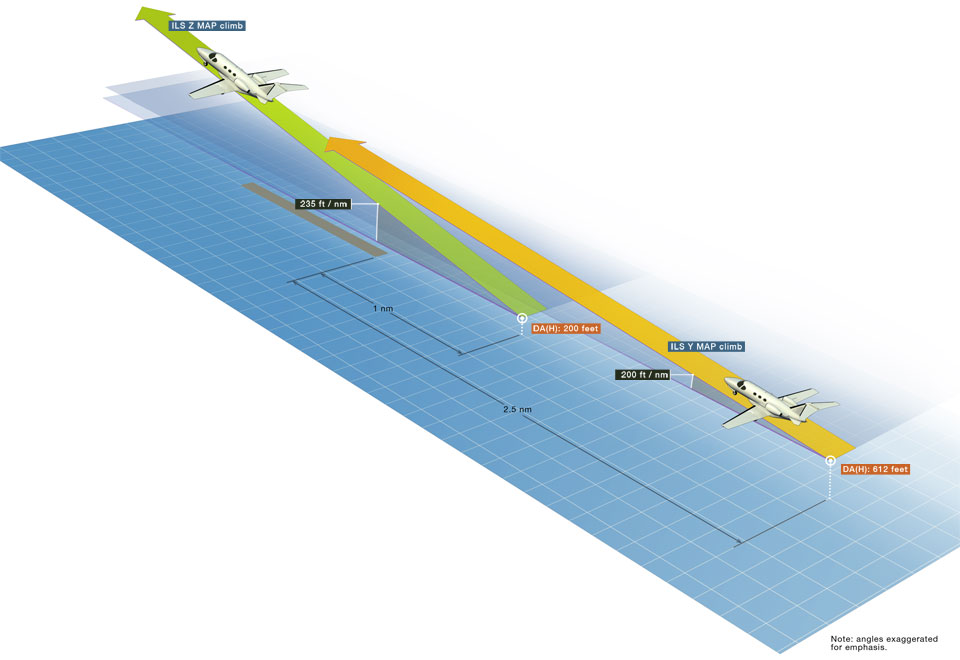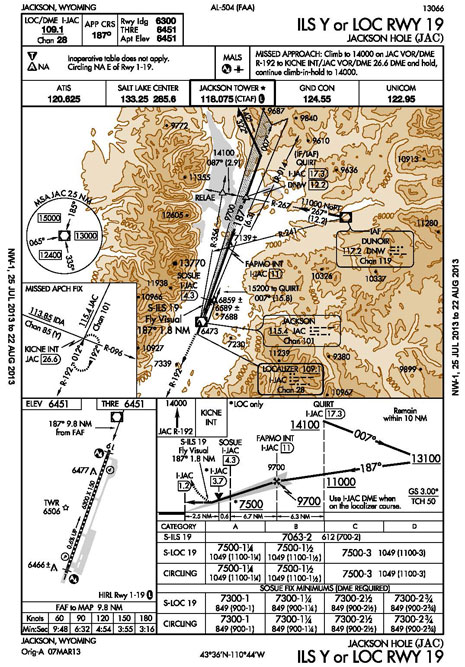Mentor Matters: Going Missed
The least likely maneuver is also the least demanding, performance-wise

On the jackson hole ILS Y Runway 19 missed approach, a climb begun at 612 feet agl can be relatively shallow at 200 feet per nautical mile (yellow trajectory). But the ILS Z missed approach to the same runway (green trajectory) begins at 200 feet agl, yieldinga higher climb gradient to assure the same terrain clearance.


As compared to the performance demands of takeoff, missed approaches require very little of an aircraft. Consider that when needing to clear the same terrain as a departing aircraft, an aircraft conducting a missed approach typically is starting the climb from at least one to two miles farther from the runway and terrain, as well as from several hundred feet higher. The lateral and vertical advantages combine to mean the climb gradient required on a missed will be significantly less than that required from a departure procedure.
The same minimum climb performance is expected of an aircraft on a missed as on departure—200 feet of climb per nautical mile of forward travel, or a 3.3-percent gradient. Because of the superior position of an aircraft starting a missed approach, this minimum gradient is usually sufficient even in mountainous areas. Some approaches do, however, require a higher-than-standard gradient on the missed approach, if the lowest of minimums are to be achieved.
Consider the ILS 19 in Jackson Hole, Wyoming. Two approach diagrams are published—the ILS Y 19 and the ILS Z 19. Both utilize the same navaid, but the “Z” has minimums of 200 feet (above the runway), while the “Y” only allows descent to 612 feet. A note on the “Z” approach chart states, “Missed approach requires a minimum climb of 235 feet per nm to 10,600 feet. If unable to comply, use ILS Y or LOC Rwy 19.” By beginning the missed approach 400 feet closer to the ground, and more than a mile closer to the runway, a nearly 20 percent higher climb gradient must be maintained to ensure adequate terrain separation.
European airports often see the concept of tying approach minimums to the ability to climb on the missed taken to a staggering extent. The ILS 18 into Chambery, France, for example, has an entire page dedicated to 84 boxes of possible minimums, varying with the gradient achievable on the miss, as well as the indicated airspeed that will be flown during the missed approach.
As on departure, multiengine aircraft are only required to be able to meet missed- approach climb gradients with all engines operating, not after an engine failure. The terminal instrument procedures (TERPS) document used by the FAA to create approaches acknowledges that “extraordinary circumstances” such as a mechanical malfunction might cause an aircraft to be unable to achieve the 200 feet per nm minimum climb gradient, leading to inadequate terrain clearance. It adds that procedures beyond those created with TERPS are required to cope with such scenarios.
While the FAA does state that operators are responsible for developing contingency procedures to be followed should an engine failure occur during takeoff, no similar requirement is imposed to have an alternate missed approach path, should a missed gradient not be achievable following an engine loss. Even Part 121 operators are not required to perform potentially weight-limiting obstacle clearance analysis for single-engine missed approaches, but rather are only encouraged to provide their pilots with the safest lateral path to follow during such an event.
What the FAA seems to be acknowledging is that while every flight involves a takeoff, very few flights will see a missed approach. To have the compound troubles of an unrestartable engine failure and a missed approach is extraordinarily unlikely; so much so that the same level of planning that goes into departure is not required—even for the tightly regulated airlines.
Neil Singer is a Master CFI with more than 7,200 hours in 15 years of flying.


